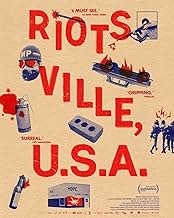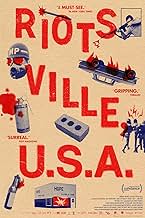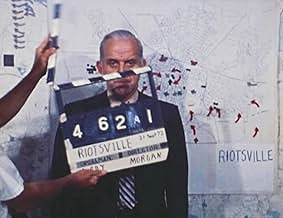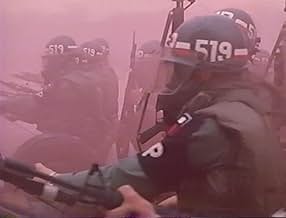Agrega una trama en tu idiomaWelcome to Riotsville, a fictional town built by the US military. Using all archival footage, the film explores the militarization of the police and creates a counter-narrative to the nation... Leer todoWelcome to Riotsville, a fictional town built by the US military. Using all archival footage, the film explores the militarization of the police and creates a counter-narrative to the nation's reaction to the uprisings of the late '60s.Welcome to Riotsville, a fictional town built by the US military. Using all archival footage, the film explores the militarization of the police and creates a counter-narrative to the nation's reaction to the uprisings of the late '60s.
- Premios
- 4 premios ganados y 10 nominaciones en total
Lyndon B. Johnson
- Self
- (material de archivo)
Otto Kerner
- Self - Chairman
- (material de archivo)
- (as Governor Otto Kerner)
Edward P. Morgan
- Self - PBL Chief Correspondent
- (material de archivo)
Robert Curvin
- Self - Former Chairman, Neward CORE
- (material de archivo)
Leonard Kowalewski
- Self - Newark Police
- (material de archivo)
John Harrington
- Self - Fraternal Order of Police
- (material de archivo)
- (as Sgt. John Harrington)
Albert Cleage
- Self
- (material de archivo)
- (as The Rev. Albert Cleage)
Alvin F. Poussaint
- Self - Tufts University
- (material de archivo)
- (as Dr. Albert Poussaint)
Fred Harris
- Self - Commission Member
- (material de archivo)
- (as Sen. Fred R Harris)
Dick Gregory
- Self
- (material de archivo)
Roger Mudd
- Self
- (material de archivo)
Robert Byrd
- Self
- (archivo de sonido)
- (as Senator Robert Byrd)
Jimmy Collier
- Self
- (material de archivo)
Frederick Douglass Kirkpatrick
- Self
- (material de archivo)
- (as Rev. Frederick Douglass Kirkpatrick)
Ronald Reagan
- Self
- (material de archivo)
Spiro Agnew
- Self
- (material de archivo)
- (as Gov. Spiro Agnew)
Strom Thurmond
- Self
- (material de archivo)
- (as Sen. Strom Thurmond)
- Dirección
- Guionista
- Todo el elenco y el equipo
- Producción, taquilla y más en IMDbPro
Opiniones destacadas
But this was far below what i expected from a historical perspective. Its the black and white stigmata over and over again, and what really should be delved with, namely how antiriot enforcement where thought to be and how it came to be in the name of riotsville usa drowns in a claustrophobic, cataclysmic psychedelic epileptic triggering lightshows and overfocused still, and a neoneoneoultra composed musical scored( like norwegian composer arne nordheim) makes this a complete rotten mess historywise. Its narrative voice never tells how much was spended or how large this antiriotforce buildup was, and the real riots that couldve made this documentary a real document of history lacks completely.
So if this is how riots have been handled over the years then its time to look somewhere else. As a filmproduct it lacks quality on most bases, and the amount of positive criticism over a ribbed and untelling way to tell a story that has been told here really feels fictitious. The grumpy old man doesnt recommend this one, and will cry out a call to the big documentarymakers to make a series about the real rioting 60's and the real face of the crammed crow.
So if this is how riots have been handled over the years then its time to look somewhere else. As a filmproduct it lacks quality on most bases, and the amount of positive criticism over a ribbed and untelling way to tell a story that has been told here really feels fictitious. The grumpy old man doesnt recommend this one, and will cry out a call to the big documentarymakers to make a series about the real rioting 60's and the real face of the crammed crow.
It was disappointing to watch what should have been a worthwhile project. In terms of the footage presented, we see way more outtakes than the actual controversial enactments of the staged "riots" for the benefit of an audience of Generals and Politicians.
The one thing that seemed to be a revelation was that the idea of Snipers was actually one which was fabricated by the police in order to show that they should bring in heavy artillery, but the reality is that the snipers were just police plants shooting wildly, even at each other to invoke a response -- there was only one case of an unknown sniper who attempted to shoot at the police while drunk, and so the sniper missed every target.
But the problem with the documentary is the frequent use of non-essential footage, "padding" the scenes with news commentators prattle, and often playing TV logos and even a commercial or promotional tape in order to add commentary on the alignment of the news media, only to miss the target much like the sniper -- the commercials, as much as they are nostalgic and naive, are wasted material in the otherwise over-long project. Cutting out 30 minutes of this wasted footage would have better served the filmmaker's goal.
Of course, then it would not be considered a contender for a Feature by the Academy, which one senses is the filmmaker's attitude in this presentation -- as evidenced by the use of overly dramatic voice-over consisting of poetic nonsense.
Since the filmmaker sees the found footage as so extraordinary, we are intrigued by the idea that we might then be able to see the actual riot footage of the real events, such as the Democratic National Convention in 1968, but none of this happens, and instead we are given a somewhat watered down version of the event at the Republican National Convention the same year when Richard Nixon was nominated -- and the protest by a small group of black ghetto denizens was a complete and utter failure.
The one thing that seemed to be a revelation was that the idea of Snipers was actually one which was fabricated by the police in order to show that they should bring in heavy artillery, but the reality is that the snipers were just police plants shooting wildly, even at each other to invoke a response -- there was only one case of an unknown sniper who attempted to shoot at the police while drunk, and so the sniper missed every target.
But the problem with the documentary is the frequent use of non-essential footage, "padding" the scenes with news commentators prattle, and often playing TV logos and even a commercial or promotional tape in order to add commentary on the alignment of the news media, only to miss the target much like the sniper -- the commercials, as much as they are nostalgic and naive, are wasted material in the otherwise over-long project. Cutting out 30 minutes of this wasted footage would have better served the filmmaker's goal.
Of course, then it would not be considered a contender for a Feature by the Academy, which one senses is the filmmaker's attitude in this presentation -- as evidenced by the use of overly dramatic voice-over consisting of poetic nonsense.
Since the filmmaker sees the found footage as so extraordinary, we are intrigued by the idea that we might then be able to see the actual riot footage of the real events, such as the Democratic National Convention in 1968, but none of this happens, and instead we are given a somewhat watered down version of the event at the Republican National Convention the same year when Richard Nixon was nominated -- and the protest by a small group of black ghetto denizens was a complete and utter failure.
It's unfortunate when a film has an important message to convey but does a poor job of saying what it has to say. That's the problem with this documentary about the policies and practices underlying government efforts to control violent civil disobedience in major US cities during the mid to late 1960s. It focuses on the training programs employed at US Army bases where model cities (called "Riotsville") were built to stage simulated disturbances used for instructing military and police forces on how to quell such outbreaks in line with official government policies. But the film goes beyond that, trying to explain why these incidents were occurring with increasing frequency at the time and why such extensive training measures had become necessary. In doing so, the picture examines the frustrations associated with, and subsequent reactions to, the issues of poverty, racism, police brutality, inequality and the impact of the Vietnam War, among others, principally in minority inner city communities. It tells this story using only archive footage from the time, drawn from television broadcasts and official US military training films. However, given the broad scope of this story, director Sierra Pettengill's third feature outing doesn't delve nearly deep enough into these issues, somewhat surprising given the wealth of material at the filmmaker's disposal. Nor does it tie the Riotsville project to these larger questions as well as it could, relying more on implication than connection. Moreover, this shallow, underdeveloped approach is further undercut by a number of poorly chosen video segments and others in desperate need of editing out extraneous content. Add to that far too many explanatory subtitles and a number of dull, overwritten voiceovers seeking to philosophically elaborate on its conclusions, and you've got a watered down presentation of material deserving to be delivered with a greater sense of hard-hitting urgency. This is the sort of film that should make audiences angry, not put them to sleep, but this offering does more to promote the latter than the former. This is a story that would have been better told through more skillful directorial hands for it to have the impact it requires. Unfortunately, that's not the case here.
This film struggles with some fascinating archival footage and trying to stretch both the length and message of the film too broadly around that.
This country struggles with civil rights sadly over and over again, now to the point where the one thing uniting far too many citizens is an unwavering distrust of the government. Documenting protests is important in understanding both the strength and vulnerability of the not-always-so-United States. That said I feel like any assembly of mobs...protesters (also I guess anti-protesters generally few but vociferous) and then the police force can bring out the mob mentality on both sides.
In general color me wary of both, but especially the ones where everyone in the mob has a gun.
Anyways this film might best be served by watching the trailer or a sped-up or excerpted version of it. I assume the abridged version won't have the slow zoom and defocus on pixelated faces. Although that would do a disservice to DJ Rupture's excellent soundtrack work.
Looking forward... 1) Well I do think for all of the struggles, the arc or the USA does bend towards a better country...often painfully and painfully slowly.
2) The notion of test cities for police exercises is still going on afaik, didn't the former Blackwater corporation utilize them recently before they re-branded or whatever?
3) Sierra Pettengill might be an excellent resource for gathering archival footage for other directors' projects. I see she was part of the team for the Jarmusch documentary on the The Stooges (with Iggy that is, not Curly).
I struggle to recommend this, but with expectations lowered for less of an expose and more of an art collage meditation with occasional Gulf advertisements - it might be worth an hour of your time, although the running time is 1.5 hours.
This country struggles with civil rights sadly over and over again, now to the point where the one thing uniting far too many citizens is an unwavering distrust of the government. Documenting protests is important in understanding both the strength and vulnerability of the not-always-so-United States. That said I feel like any assembly of mobs...protesters (also I guess anti-protesters generally few but vociferous) and then the police force can bring out the mob mentality on both sides.
In general color me wary of both, but especially the ones where everyone in the mob has a gun.
Anyways this film might best be served by watching the trailer or a sped-up or excerpted version of it. I assume the abridged version won't have the slow zoom and defocus on pixelated faces. Although that would do a disservice to DJ Rupture's excellent soundtrack work.
Looking forward... 1) Well I do think for all of the struggles, the arc or the USA does bend towards a better country...often painfully and painfully slowly.
2) The notion of test cities for police exercises is still going on afaik, didn't the former Blackwater corporation utilize them recently before they re-branded or whatever?
3) Sierra Pettengill might be an excellent resource for gathering archival footage for other directors' projects. I see she was part of the team for the Jarmusch documentary on the The Stooges (with Iggy that is, not Curly).
I struggle to recommend this, but with expectations lowered for less of an expose and more of an art collage meditation with occasional Gulf advertisements - it might be worth an hour of your time, although the running time is 1.5 hours.
Violent police repression as a first response tactic against protests, still seems to dominate todays American society as much as it did during the sixties.
This eyeopening documentary gives us a surprisingly detailed insight into how authorities reacted to the first mass race riots and civil rights protests during the sixties.
This documentary has got lots of interesting LIVE public television footage about racism and inequality and police brutality and it uses a police training video for how to handle riots as a red line through this entire movie about how the goverment responded to civil rights protests and race riots during the sixties.
In general the government did 2 things to "respond" to the protests and race riots:
1.
The authorities investigated the cause of race riots during the sixties by appointing a commision of conservatives who came to a similar conclusion as the African American people who were protesting, namely that American society was brutally split and full of inequality and racism.
2.
Shocked by this unwelcome outcome of the conservative comission the government only accepted one tiny subconclusion out of the entire comission's report and that was to give the police more weapons to repress riots...
This documentaries' strength lies in the abstract narration and style. Because of that style the total oblivion of goverment officials becomes even more painfully clear for all to see...
I have seen several documentaries about racism and police brutality lately and this is the one that got me thinking the most about the world of total oblivion that politicians are wallowing in...
This eyeopening documentary gives us a surprisingly detailed insight into how authorities reacted to the first mass race riots and civil rights protests during the sixties.
This documentary has got lots of interesting LIVE public television footage about racism and inequality and police brutality and it uses a police training video for how to handle riots as a red line through this entire movie about how the goverment responded to civil rights protests and race riots during the sixties.
In general the government did 2 things to "respond" to the protests and race riots:
1.
The authorities investigated the cause of race riots during the sixties by appointing a commision of conservatives who came to a similar conclusion as the African American people who were protesting, namely that American society was brutally split and full of inequality and racism.
2.
Shocked by this unwelcome outcome of the conservative comission the government only accepted one tiny subconclusion out of the entire comission's report and that was to give the police more weapons to repress riots...
This documentaries' strength lies in the abstract narration and style. Because of that style the total oblivion of goverment officials becomes even more painfully clear for all to see...
I have seen several documentaries about racism and police brutality lately and this is the one that got me thinking the most about the world of total oblivion that politicians are wallowing in...
Selecciones populares
Inicia sesión para calificar y agrega a la lista de videos para obtener recomendaciones personalizadas
- How long is Riotsville, U.S.A.?Con tecnología de Alexa
Detalles
Taquilla
- Total en EE. UU. y Canadá
- USD 40,960
- Fin de semana de estreno en EE. UU. y Canadá
- USD 5,597
- 18 sep 2022
- Total a nivel mundial
- USD 44,392
- Tiempo de ejecución
- 1h 31min(91 min)
- Color
Contribuir a esta página
Sugiere una edición o agrega el contenido que falta

























